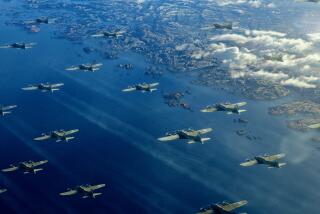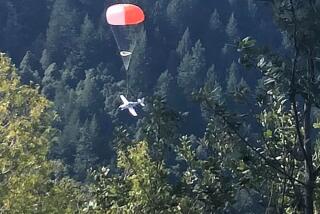PILOT SURVIVAL
As U.S. sorties in the Gulf War climb to about 20,000, chances of pilots being shot down behind enemy lines increase. Through well-rehearsed rescue procedures, a pilot’s ability to survive after his plane has been crippled is quite good. Besides realistic simulation of how to eject from a damaged jet, pilots also receive rigorous training in escape procedures.
1. PLANE IS HIT
After the plane has been hit, the pilot tries to level his craft. If he can, he reduces the plane to subsonic speed. If the pilot were to eject from a plane traveling too fast, he would die. Many planes are able to survive combat damage long enough to allow the pilot to eject safely.
ANGLE OF JET AT EJECTION One of the most important factors in the pilot’s survival is the angle of the plane when he ejects. The optimal position is for the plane to be parallel to the ground.
2. EJECTING FROM THE PLANE
After the pilot ejects, he is struck by a massive blast of cold air. The effect has been compared to being hit by a sack of cement traveling at 500 m.p.h. A drogue parachute opens to stabilize the seat. The main parachute can be opened either manually or automatically at a certain altitude. If he has ejected at extremely high altitudes, the chute may not open immediately.
3. FREE FALL
If the pilot eject at a high altitude (for instance, at more than 30,000 feet), the limited oxygen and extreme cold may cause hypothermia. The mail chute often is not deployed until the pilot has fallen much lower, perhaps as low as 5,000 feet. If the chute opens at higher altitudes, it is visible from greater distances.
4. WHERE TO COME DOWN?
If the pilot is falling toward an undesirable area, he can manually open his chute earlier and hope that winds carry him to a different location. Once the parachute opens, the seat falls separately to the ground. Generally, pilots in the Gulf War prefer to come down in the water rather than on land. Because of the U.S. naval superiority, pilots feel they have little chance of being captured in the water.
5. LOCATION OF DOWNED PILOT
Observation planes are usually sent to locate the pilot. There are several ways a pilot can signal rescue aircraft, including a hand-held radio or flares (both of which may give away his position). He can also use a mirror to signal aircraft up to 10 miles away without giving away his position to enemy ground forces.
6. RESCUE MISSION
After the pilot is located, helicopters, escorted by fighter planes, are dispatched. Pilots are trained to pick suitable landing sites for helicopters. For example, they will pick a site where helicopters can land facing wind and be exposed to a minimum of enemy fire. helicopters will often not land but instead lower a hoist (in water pickups, crew members jump in to help).
EJECTION SEAT
Depending on the plane, the pilot can eject by using either a “face curtain” or “ seat handles.” The face curtain is a shield he pulls down to cover his face and is the preferred ejection system. If he is injured or unable to reach up, there is a lever between his legs that will also eject the seat. THe pilot sets off rockets, thrusting him 300-500 feet into the air.
The seat of the plane contains life raft, oxygen supply and survival kit.
PILOT’S GEAR
Americans are trained for what to expect if they become prisoners of war. They are exposed to the techniques used by the enemy, and the best ways to respond--the central tenet being to “bend without breaking.” Each pilot is given psychological counseling on how to manage the severe mood swings of captivity.
Flight vest can hold up to 40 pounds of gear: Water, rations Parachute harness Mirror, signal flares, compass Sea marker, fire sticks, rope Fire-proof gloves Pistol, knife Insect repellent Hand-held radio “G” suit Whistle, tubing, sunscreen Personal flotation device Maps Classified items
GROUND EVASION AND SURVIVAL
Once the pilot reaches the ground, he follows special instructions on surviving in that particular combat zone. Pilots are trained to move immediately away from the landing site and on how to differentiate between friendly and hostile forces. They are also trained in first aid and how to live off the land. A radio signal helps show the location of a downed pilot.
More to Read
Sign up for Essential California
The most important California stories and recommendations in your inbox every morning.
You may occasionally receive promotional content from the Los Angeles Times.









